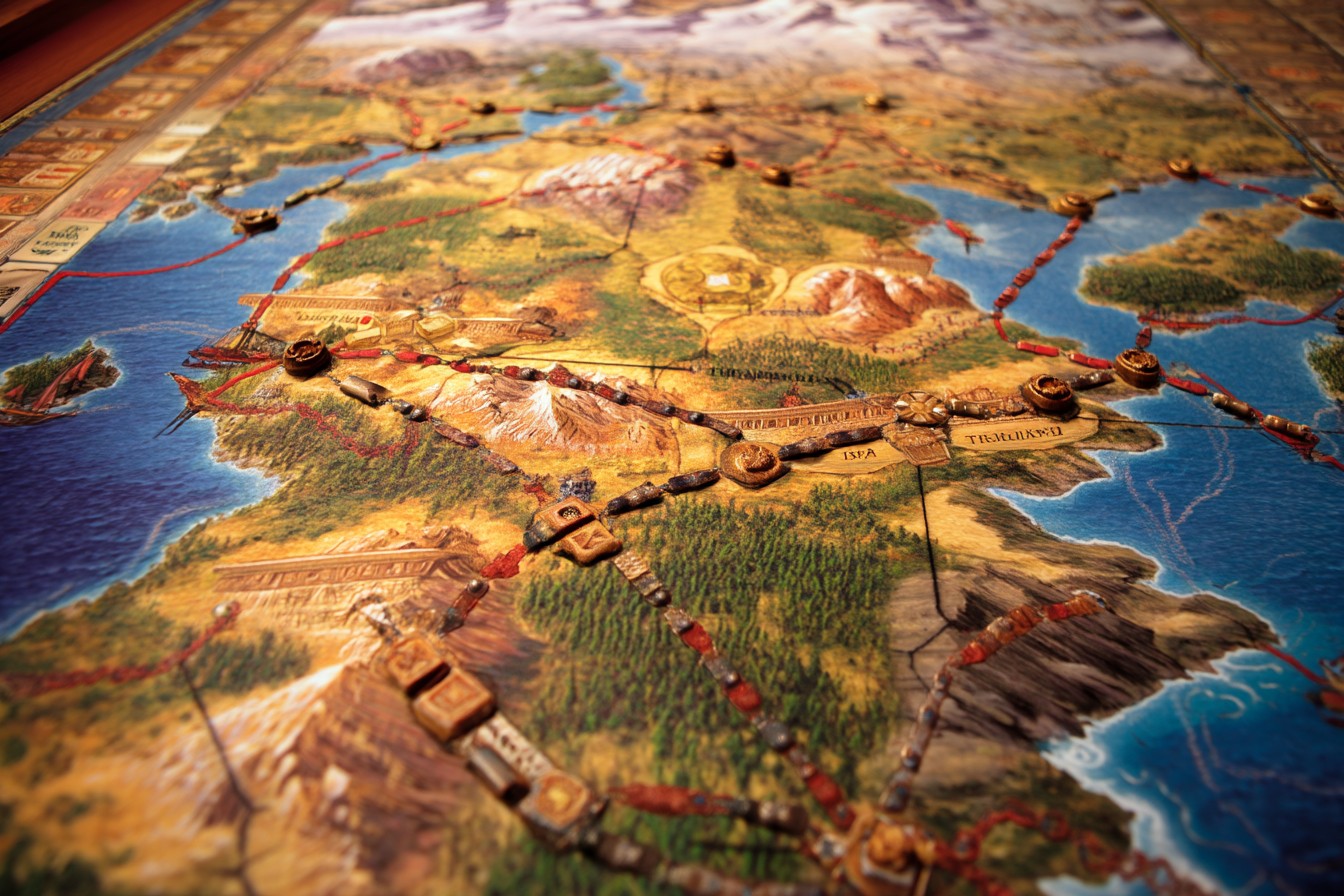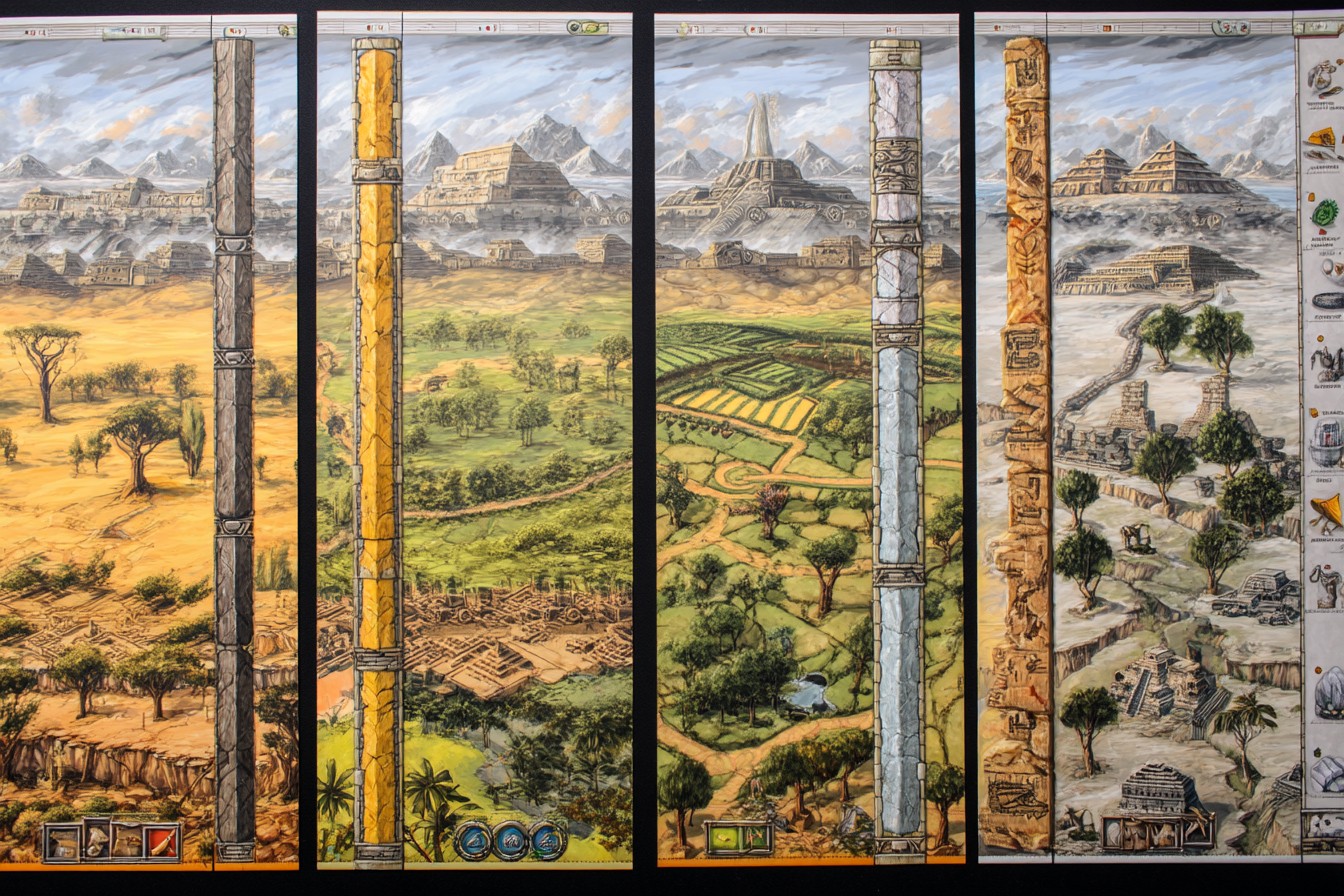The first time I played Tapestry, I spread myself too thin. Like a kid in a candy store, I wanted a bit of everything—all four advancement tracks looked so appealing that I advanced one step on each before realizing I’d created a civilization that was mediocre at everything and exceptional at nothing. Predictably, I finished dead last, while my friend Tony, who had focused almost exclusively on the Military track, steamrolled everyone with his aggressive expansion.
“You can’t do everything, David,” he said afterward with a smirk. “Pick a lane.”
After 43 games (yes, I keep track—my gaming spreadsheet is a source of good-natured ribbing in our group), I’ve learned that Tony was partly right. You do need to pick a lane—but it’s rarely just one lane. The true power in Tapestry comes from identifying the perfect intersections between advancement tracks that create force-multiplying synergies for your specific civilization.
I’ve developed what I call the “Primary/Secondary/Support” framework for track advancement that has dramatically improved my win rate. In fact, I’ve won 8 of our last 12 games using this approach, which has led to Tony now refusing to sit next to me at the table. “You always attack the player on your left,” he complained last game night, which isn’t entirely untrue.
The core insight is simple: based on your civilization’s unique abilities, you should heavily prioritize one primary track (reaching the final tier), moderately advance on a complementary secondary track (reaching tier 3-4), and make minimal but strategic advances on one or both support tracks (reaching tier 1-2). This focused approach ensures you’re maximizing the synergies between tracks while playing to your civilization’s strengths.
Let’s dig into how to identify the optimal track combinations for each civilization type:
Military-focused civilizations (Militants, Conquerors, etc.) obviously benefit from the Military track as their primary advancement path, but the secondary track choice makes a huge difference in their effectiveness. I’ve found Science works beautifully as a secondary for military civilizations—the extra dice from Science advancements significantly increase your combat effectiveness, while the technology cards often provide resource generation that fuels further military expansion.
In a memorable game where I played the Militants, I pushed hard on Military (primary) and Science (secondary), while making a single strategic advance on Exploration to secure a valuable territory. By mid-game, I was rolling three dice in combat (base die + Science bonus + Military tier 3 bonus) and consistently winning encounters, while my Science track provided the income to keep my military machine running. The combined effect was devastating.
Science-focused civilizations face a critical decision that many players get wrong: whether to pair with Technology or Military as a secondary track. After dozens of games, I’m convinced that Military provides the stronger synergy for most science civilizations. The exploration opportunities from Military advancement let you place your outposts strategically to maximize income, which fuels further Science advancement.
The Inventors, with their ability to gain additional technology cards, represent an exception to this rule. For them, Technology makes the stronger secondary track, creating a powerful engine where Science advancements fuel technology acquisition, which in turn provides benefits that make Science advancement easier.
I played a game as the Inventors where I rushed up the Science track, using my civilization ability to acquire technologies at a discount. By the second income turn, I had technologies that increased my Science income, which funded further Science advancement, which gave me more technologies… you get the idea. I barely touched Military (just one tier for basic exploration) but still won handily through sheer technological superiority.
Exploration-focused civilizations benefit from a less obvious primary/secondary combination: Exploration primary paired with Technology secondary. Many players instinctively pair Exploration with Military, which isn’t wrong but misses the incredible resource engine that Technology provides to fuel your exploration efforts.
My wife Linda demonstrated this brilliantly in our last game. Playing as the Explorers, she focused heavily on Exploration with Technology as her secondary. The resource generation from her Technology advancements funded her exploration efforts, while her Exploration bonuses gave her the perfect territories to maximize her technology benefits. She made a single strategic advance on Military just to gain the ability to conquer, but otherwise stayed laser-focused on her Exploration/Technology synergy. The resulting point engine was impressive, generating nearly 30 points in the final era alone.
Technology-focused civilizations have the most flexible pairing options, but I’ve found Technology primary with Science secondary creates the most consistent results. The income generation from Science advancements fuels your technology acquisition, while the extra dice and bonuses from Science make your civilization more adaptable.
In one particularly satisfying game, I played the Tinkerers with their technology cost reduction ability. I rushed Technology as my primary, using Science as my secondary for the income and dice bonuses. By mid-game, I was acquiring technologies at a significant discount and had built a synergistic tableau that generated resources, victory points, and advancement opportunities simultaneously. The key insight was using my Science advancements not for their immediate benefits but to fuel the Technology engine.
Beyond these broad categories, specific civilization abilities sometimes suggest counterintuitive track combinations. The Alchemists, for instance, with their ability to convert resources, benefit tremendously from Exploration primary and Technology secondary—a combination that generates a wide variety of resources that their conversion ability can optimize.
I once played against my friend Jeff who used this exact combination with the Alchemists. By the final era, he was converting his abundant resources into exactly what he needed each turn, allowing him to make opportunistic advancements that the rest of us couldn’t match. His civilization wasn’t the strongest in any single category but had unmatched flexibility.
The Craftsmen present another interesting case. Their ability to gain bonus resources when gaining tapestry cards suggests Technology primary (for the tapestry card frequency), but I’ve found Science actually makes a stronger primary track with Technology as secondary. The income from Science ensures you can always play the tapestry cards you receive, maximizing the benefit from your civilization ability.
My son Alex used this approach in a recent game, combining Science primary, Technology secondary, and a minimal Exploration investment. The Science income funded his tapestry card plays, which triggered his Craftsmen ability for bonus resources, which further fueled his advancement. It was a beautiful cascade effect that none of us could match.
The timing of track advancements is just as important as which tracks you choose. Many players make the mistake of advancing evenly across their chosen tracks, which dilutes their civilization’s strengths at critical moments. Instead, I recommend a “sprint and consolidate” approach—push hard on your primary track early, then develop your secondary track, then make strategic advances on support tracks only when specific benefits align with your strategy.
In practice, this often means reaching tier 3-4 on your primary track before making significant investments in your secondary track. This focused approach ensures you’re gaining the force-multiplying benefits of the higher tiers on your primary track when they matter most—during the middle eras when the game state is still fluid.
I demonstrated this in a recent game as the Isolationists. I sprinted up the Military track to tier 4 before making any significant advances on my secondary Science track. This allowed me to establish a dominant position on the map early, claiming key territories that provided income for the remainder of the game. Only after securing this position did I develop my Science track to enhance my combat effectiveness and resource generation.
The importance of making strategic one-tier advances on support tracks cannot be overstated. Often, the first tier of a track provides benefits disproportionate to its cost, especially when it enables a key element of your strategy. For instance, a Science-focused civilization might benefit enormously from a single Military advancement just to gain exploration capabilities.
My friend Tony (yes, the same one who told me to “pick a lane”) demonstrated this perfectly in our most recent game. Playing as the Scientists, he focused primarily on Science with Technology as his secondary. However, he made a single strategic advance on Military specifically to gain exploration capabilities, which he used to place his outposts adjacent to benefit-producing territories. That one-tier investment in a support track paid dividends throughout the game.
The interact advancement on each track represents a critical decision point. These advancements allow you to affect other players, but they also divert resources from your core strategy. I’ve found that interact advancements on your primary track are usually worth taking, while those on secondary or support tracks rarely justify their opportunity cost.
In one particularly cutthroat game, I played the Militants with Military primary and Science secondary. I took the Military interact advancement early, which allowed me to conquer opponents’ territories. This not only generated points for me but denied resources to my opponents, creating a double benefit that justified the investment. However, I deliberately skipped the Science interact advancement, recognizing that the resources would be better spent advancing further on my primary Military track.
The trap tracks—those that seem aligned with your civilization but actually distract from stronger synergies—vary by civilization. For the Militants, Technology often serves as a trap track. While the extra resources seem helpful, they rarely justify the opportunity cost of not advancing further on Military or Science. For the Futurists, Exploration often becomes a trap, diverting resources from the more powerful Science/Technology combination.
I watched Kevin fall into this trap playing as the Futurists. He divided his efforts between Science, Technology, and Exploration, reasoning that all three seemed valuable. By the final era, he had advanced to tier 3 on all three tracks but reached tier 5 on none—leaving him with a civilization that had interesting options but lacked the high-tier benefits that win games.
The impact of landmark buildings on track selection cannot be overlooked. These buildings often provide benefits that complement specific tracks, creating additional synergies to consider. The Academy, for instance, pairs beautifully with Science advancement, while the Armory naturally complements a Military focus.
In a recent game, I specifically adjusted my advancement strategy to claim the Archive early, knowing its benefits would compound with my Science-focused strategy. This adjustment—making an earlier than planned advance on Exploration to reach the territory containing the Archive—paid dividends throughout the game as the Archive’s benefits multiplied the effectiveness of my Science advancements.
The final consideration in track selection is adaptability within your framework. While the Primary/Secondary/Support approach provides strategic focus, the best players adjust their specific advancement timing based on the emerging game state. If a particularly valuable territory appears, a temporarily increased investment in Military or Exploration might be justified. If an opponent is clearly pursuing the same primary track as you, accelerating your advancement to claim key benefits first becomes critical.
In my most satisfying Tapestry victory, I played the Historians with Technology as my primary track and Science as secondary. When I realized my left-hand opponent was also prioritizing Technology, I temporarily diverted resources to accelerate my Technology advancement, ensuring I reached key thresholds first. This adaptive approach within my strategic framework allowed me to claim the most valuable technologies before they could, establishing a lead that persisted throughout the game.
Tapestry’s depth comes from these interacting systems—civilization abilities, advancement tracks, landmark buildings, and the emerging game state all influence optimal strategy. By applying the Primary/Secondary/Support framework, you create strategic focus while maintaining the flexibility to adapt to specific game conditions.
So the next time you sit down to play Tapestry, resist the temptation to advance evenly across all tracks. Instead, identify the track combination that creates perfect synergy with your civilization’s unique abilities. Sprint up your primary track, develop your complementary secondary track, and make strategic advances on support tracks only when specific benefits align with your strategy. This focused approach transforms Tapestry from a game of interesting but disconnected advancements into a powerful engine of civilization development—and dramatically improves your chances of victory.







Leave a Reply